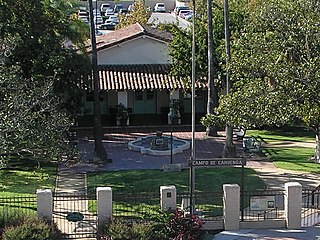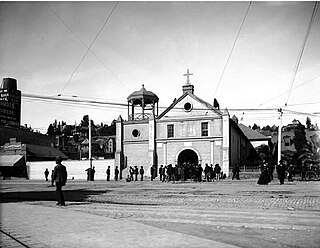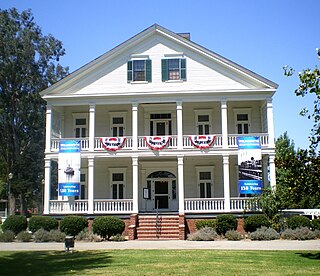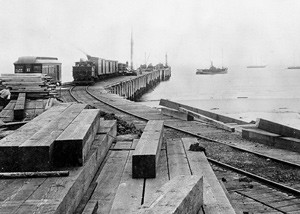
The Drum Barracks, also known as Camp Drum and the Drum Barracks Civil War Museum, is the last remaining original American Civil War era military facility in the Los Angeles area. Located in the Wilmington section of Los Angeles, near the Port of Los Angeles, it has been designated as a California Historic Landmark, a Los Angeles Historic Cultural Monument and has been listed on the National Register of Historic Places. Since 1987, it has been operated as a Civil War museum that is open to the public.

A California Historical Landmark (CHL) is a building, structure, site, or place in California that has been determined to have statewide historical landmark significance.

The Campo de Cahuenga, near the historic Cahuenga Pass in present-day Studio City, California, was an adobe ranch house on the Rancho Cahuenga where the Treaty of Cahuenga was signed between Lieutenant Colonel John C. Frémont and General Andrés Pico in 1847, ending hostilities in California between Mexico and the United States. The subsequent Treaty of Guadalupe Hidalgo of 1848, ceding California, parts of Colorado, Nevada, New Mexico, and Arizona to the United States, formally ended the Mexican–American War. From 1858 to 1861 the Campo de Cahuenga became a Butterfield Stage Station.

La Iglesia de Nuestra Señora la Reina de los Ángeles is a historic Catholic church in El Pueblo de los Ángeles Historical Monument in northern downtown Los Angeles, California. The church was founded by the Spanish in the early 19th century when modern-day California was under Spanish rule and known as Alta California in the Viceroyalty of New Spain.

San Pedro Municipal Ferry Building is a former Los Angeles Harbor Department ferry terminal building located at Sixth Street at Harbor Boulevard in the community of San Pedro in Los Angeles, California.

Lummis House, also known as El Alisal, is a Rustic American Craftsman stone house built by Charles Fletcher Lummis in the late 19th and early 20th centuries. Located on the edge of Arroyo Seco in northeast Los Angeles, California, the house's name means "alder grove" in Spanish.

Banning House, also known as the General Phineas Banning Residence Museum, is a historic Greek Revival-Victorian home in the Wilmington section of Los Angeles, California. Built in 1863 by Phineas Banning near the original San Pedro Bay, it remained in the Banning family until 1925 and has been owned by the City of Los Angeles since 1927. The home, barn and gardens are now operated as a museum. The Banning House property, also known as Banning Park, has been designated as a city Los Angeles Historic-Cultural Monument and state California Historical Landmark and has been federally listed on the National Register of Historic Places.

Los Angeles Historic-Cultural Monuments are sites which have been designated by the Los Angeles, California, Cultural Heritage Commission as worthy of preservation based on architectural, historic and cultural criteria.

Memory Chapel is a Los Angeles Historic-Cultural Monument located in the Wilmington section of Los Angeles, California, near the Port of Los Angeles. Built in 1870 in the Carpenter Gothic Victorian architecture style, it is the oldest Protestant church in the Harbor area. Originally located at "F" Street and Marine Avenue, it was moved to its present location in 1939. In 1946, the chapel was designated as a historical landmark under auspices of the Wilmington Parlor No. 278, Native Daughters of the Golden West.

The place of McFadden Wharf was designated a California Historic Landmark (No.794) on July 3, 1964.











